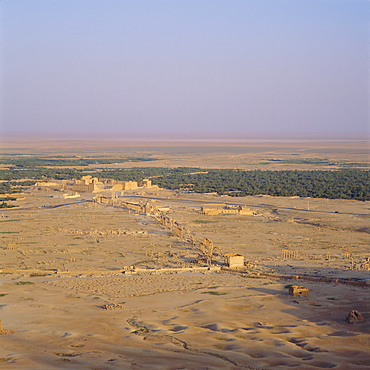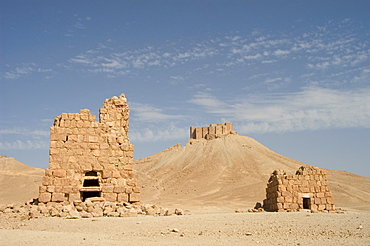Recent searches
Loading...
817-441952 - Sunrise over the ruins of the ancient city of Palmyra, Syria.
817-441945 - The bas-reliefs on the marble in Temple of Bel in the ancient city of Palmyra, Syria.
817-441946 - Ruins Temple of Bel in the ancient city of Palmyra, Syria.
1113-87925 - Close up of a Palmyra Palm leaf, Spa Garden, Hotel Pimalai, Ao Kantiang, Ko Lanta, Thailand
857-69586 - Palmyra, Syria - January, 2008: Roman ruins in the desert. Palmyra or Tadmore was a 2nd century AD desert oasis used as a strategic staging post for caravans traveling between the Mediterranean Sea and the east. It was also settled by the Assyrians, and Persians.
857-69590 - Palmyra, Syria - January, 2008: Bedouin man playing a traditional instrument.
700-11624 - Syria, Palmyra Oasis, The Roman Ruins, Remnants Of The 1200m Colonnade Edging The Cardo (Main Road In The Roman City Center)
817-249771 - The archeological site of the greco-roman ruins of the city of Palmyra and in the back the Qalaat Ibn Man castle at blue sky, Tadmur, Syria, Near East, Asia
817-233023 - View of the Tetrapylon of Palmyra, one of its most famous views nowadays Tetrapylon comes from the Greek which means four gates, built in Roman Times in crossroads or like in Palmyra: to mark a change of direction in the main avenue
817-198428 - Amphitheater, Ancient city of Palmyra, Syria
817-37940 - Archaeological museum, old Greco-Roman city of Palmyra, Syria
817-27748 - Dattes seller, Ruins of the ancient Roman city in the Palmyra oasis, Syria
797-934 - SYRIA Central Tadmur Monumental arch. High central arch flanked by a lower arch on each side with colonnaded street part seen behind and masonry ruins in the foreground. Palmyra Palmyra
76-1437 - Triumphal arch, Palmyra, UNESCO World Heritage Site, Syria, Middle East
557-912 - Sunrise on main street, Palmyra, UNESCO World Heritage Site, Syria, Middle East
557-778 - The Monumental Arch, at the ancient Graeco-Roman city of Palmyra, UNESCO World Heritage Site, Syria, Middle East
700-7305 - Syria, West Desert, Oasis Of Palmyra, Local Fresh Dates
700-7300 - Syria, West Desert, Ruins Of Palmyra Columnades , Arab Castle Qalaat Ibn Maan Behind
700-7298 - Syria, West Desert, Ruins Of The Ancient City Of Palmyra, Gate Of Roman Cardo
700-7294 - Syria, West Desert, Head Of A Bedouins Camel Near Palmyra
700-7301 - Syria, West Desert, Ruins Of The Ancient City Of Palmyra, Gate Of Roman Cardo Biker And Noticeboard At Fore
700-7186 - Syria, Palmyra, Antique Roman Statue For A Dead
700-11643 - Syria, Palmyra Oasis, The Roman Ruins, Remnants Of The 1200m Colonnade Edging The Cardo (Main Road In The Roman City Center)
700-11637 - Syria, Palmyra Oasis, The Bel Temple In The Roman City Ruins, Dates Palms At Fore
700-11634 - Syria, Palmyra Oasis, A Cusmotized Local Three Wheeled Vehicle
700-11629 - Syria, Palmyra Oasis, On A Hill A Young Bedouin Shepherd Take His Sheep For Grazing Rare Grass Between Stones
700-11626 - Syria, Palmyra Oasis In The Desert, The Temple Of Bel In A Desert Environment
700-11625 - Syria, Palmyra Oasis, The Roman City Ruins, Gate Entering The 1200m Columnade Edging The Cardo (Main Road In The Roman Cities Center), Camel Riders On The Road
700-11627 - Syria, Palmyra Oasis, The Roman Ruins, Remnants Of The 1200m Colonnade Edging The Cardo (Main Road In The Roman City Center)
700-11621 - Syria, East Desert Or Steppe, Mosque In Background, At Fore An Old Cart Indicating The Famous Baghdad Cafe On The Road Between Damascus And Palmyra
700-11620 - Syria, Palmyra Oasis, The Roman Ruins, Remnants Of The 1200m Colonnade Edging The Cardo (Main Road In The Roman City Center)
700-11619 - Syria, Palmyra Oasis, The Roman Ruins, Remnants Of The 1200m Colonnade Edging The Cardo (Main Road In The Roman City Center)
700-11613 - Syria, Palmyra Oasis, The Temple Of Bel Ruins Seen From Outside
700-11612 - Syria, Palmyra Oasis, The Roman City Ruins, Remnants Of The 1200m Colonnade Edging The Cardo (Main Road In The Roman City Center) , In Foreground Collapsed Walls After Several Earthquakes, At Back The Arab Castle On Top Of A Hill
700-11605 - Syria, Palmyra Oasis, The Roman City Ruins, Remnants Of The 1200m Colonnade Edging The Cardo (Main Road In The Roman Cities Center), Location Of The Baths
700-11578 - Syria, Palmyra Oasis, The Roman Ruins, Remnants Of The 1200m Colonnade Edging The Cardo (Main Road In The Roman City Center), Arab Castle On Hill Behind
700-11577 - Syria, Palmyra Oasis, The Roman Ruins, Remnants Of The 1200m Colonnade Edging The Cardo (Main Road In The Roman City Center)
700-11574 - Syria, Palmyra Oasis, The Roman Ruins, Remnants Of The 1200m Colonnade Edging The Cardo (Main Road In The Roman City Center)
700-11573 - Syria, Palmyra Oasis, The Roman City Ruins, Remnants Of The 1200m Columnade Edging The Cardo (Main Road In The Roman Cities Center), In Fore The Open Air Theatre Then The Tetrapylons Built To Shelter 4 Statues, At Rear The Arab Castle On Top Of A Hill
700-11572 - Syria, Palmyra Oasis, The Roman City Ruins, Sign Showing The Direction Of The Open Air Roman Theatre
700-11571 - Syria, Palmyra Oasis, The Roman Ruins, Gate Entering The 1200m Long Colonnade Edging The Cardo (Main Road In The Roman City)
700-11570 - Syria, Palmyra Oasis, The Roman Ruins, Gate Entering The 1200m Long Colonnade Edging The Cardo (Main Road In The Roman City)
700-11568 - Syria, Palmyra Oasis, The Roman City Ruins, Remnants Of The 1200m Columnade Edging The Cardo (Main Road In The Roman Cities Center), In Fore The Open Air Theatre Then The Tetrapylons Built To Shelter 4 Statues, At Rear The Arab Castle On Top Of A Hill
700-11567 - Syria, Palmyra Oasis, The Temple Of Bel Consecrated In 32 Ad, View Of The Temple Yard Through A Sanctuary Gate
700-11551 - Syria, Palmyra Oasis, The Temple Consecrated In Year 32 To God Bel Seen In Silhouette At Sunrise
700-11549 - Syria, The East Desert Or Steppe, A Lonesome Mosque Close To Palmyra Oasis
700-11536 - Syria, Palmyra Oasis, Freshly Harvested Dates Of Different Species In October
391-6435 - Roman Triumphal Arch, 1st century AD, Palmyra, Syria, Middle East
700-6077 - The archaeological site and Arab castle, Palmyra, UNESCO World Heritage Site, Syria, Middle East
391-6368 - View over Graeco-Roman city towards Roman Temple of Bel, 45 AD, Palmyra, Syria, Middle East
391-6358 - Roman Temple of Bel, 45 AD, Palmyra, Syria, Middle East
712-2220 - Grand colonnade and the Arab castle, Palmyra, UNESCO World Heritage Site, Syria, Middle East
712-2232 - Great colonnade and the Arab castle beyond, Palmyra, UNESCO World Heritage Site, Syria, Middle East
700-1579 - Palmyra, ruins of Roman city, Syria, Middle East
712-2243 - The archaeological site, Palmyra, UNESCO World Heritage Site, Syria, Middle East
391-6143 - Tetrapylon on Graeco-Roman columned main street, 1st century AD, Palmyra, Syria, Middle East
29-2096 - Triumphal Arch, colonaded street of Roman city, Palmyra, Syria, Middle East
391-6140 - Columned main street, 1st century BC to 3rd century AD, Palmyra, Syria
391-6453 - Graeco-Roman Agora, Palmyra, Syria, Middle East
391-6355 - Roman Temple of Bel (Baal), 45 AD, Palmyra, Syria
733-876 - Sunset, archaelogical ruins, Palmyra, UNESCO World Heritage Site, Syria, Middle East
733-875 - Sunset, archaelogical ruins, Palmyra, UNESCO World Heritage Site, Syria, Middle East
391-6377 - Roman Temple of Baal-Shamine, 23 AD, Palmyra, Syria, Middle East
733-877 - Sunset, archaelogical ruins, Palmyra, UNESCO World Heritage Site, Syria, Middle East
391-6351 - Roman Temple of Bel, 45 AD, Palmyra, Syria, Middle East
391-6366 - Qalaat Ibn Maan, 17th century Arab Castle overlooking the Graeco-Roman city, Palmyra, Syria, Middle East
391-6432 - The Roman Baths of Diocletian dating from the 3rd century AD, and the columned main street dating from the 1st century AD, at the ancient Graeco-Roman city of Palmyra, UNESCO World Heritage Site, Syria, Middle East
391-6445 - The entrance to the Roman Amphitheatre dating from the 1st century AD, at the ancient Graeco-Roman city of Palmyra, UNESCO World Heritage Site, Syria, Middle East
391-6522 - View over the Palmyrene Tower Tombs, multi-storey burial chambers dating from the 1st and 2nd centuries AD, at the ancient Graeco-Roman city of Palmyra, UNESCO World Heritage Site, Syria, Middle East
615-691 - Boy on camel in front of the great colonnade, Palmyra, UNESCO World Heritage Site, Syria, Middle East
733-856 - Young men on camels, monumental arch, archaelogical ruins, Palmyra, UNESCO World Heritage Site, Syria, Middle East
733-860 - Monumental arch, archaelogical ruins, Palmyra, UNESCO World Heritage Site, Syria, Middle East
733-862 - Colonnades, archaelogical ruins, Palmyra, UNESCO World Heritage Site, Syria, Middle East
733-864 - Qala'at ibn Maan citadel castle, archaelogical ruins, Palmyra, Syria, Middle East
733-865 - Qala'at ibn Maan citadel castle, archaelogical ruins, Palmyra, Syria, Middle East
733-866 - Archaeological ruins, and Qala'at ibn Maan castle in distance, Palmyra, UNESCO World Heritage Site, Syria, Middle East
733-872 - Qala'at ibn Maan Citadel Castle, Palmyra, Syria, Middle East
733-854 - Tourist camel ride, monumental arch, archaelogical ruins, Palmyra, UNESCO World Heritage Site, Syria, Middle East
733-868 - Qala'at ibn Maan castle seen through monumental arch, archaelogical ruins, Palmyra, UNESCO World Heritage Site, Syria, Middle East
733-853 - Tourist camel ride, monumental arch, archaelogical ruins, Palmyra, UNESCO World Heritage Site, Syria, Middle East
733-852 - Temple of Bel, archaelogical ruins, Palmyra, UNESCO World Heritage Site, Syria, Middle East
712-2246 - Monumental arch, Palmyra, UNESCO World Heritage Site, Syria, Middle East
391-6376 - Roman temple of Baal-Shamine, dating from 23 AD, Palmyra, UNESCO World Heritage Site, Syria, Middle East
712-2221 - Monumental arch at archaeological site, with Arab castle beyond, Palmyra, UNESCO World Heritage Site, Syria, Middle East
391-6464 - The Camp of Diocletian, dating from the Roman period, 2nd century AD, at the ancient Graeco-Roman city of Palmyra, UNESCO World Heritage Site, Syria, Middle East
391-6338 - The Tetrapylon and the columned main street dating from the 1st century AD, at the ancient Graeco-Roman city of Palmyra, UNESCO World Heritage Site, Syria, Middle East
712-2222 - Funerary temple at archaeological site and Arab castle beyond, Palmyra, UNESCO World Heritage Site, Syria, Middle East
733-878 - Hill top view, archaelogical ruins, Palmyra, UNESCO World Heritage Site, Syria, Middle East
615-695 - Ruins, Palmyra, UNESCO World Heritage Site, Syria, Middle East



































































































